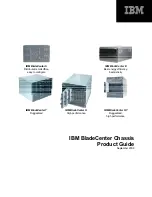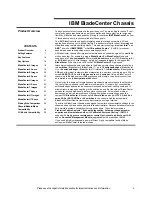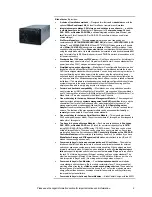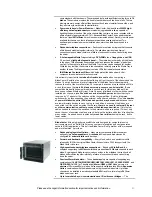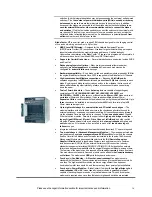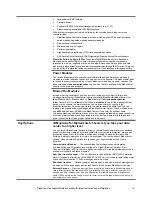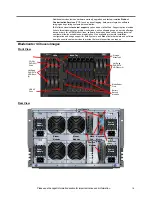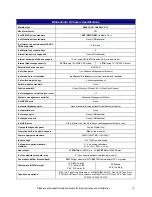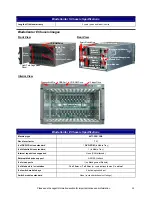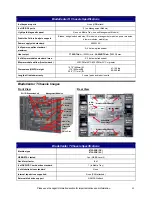
BladeCenter S
provides:
•
A choice of installation methods
— Designed for either
rack
or
deskside
use with the
optional
Office Enablement Kit,
it’s ideal for offices or remote/branch locations.
•
Integrated compute blades, SAN storage, and switches in one chassis
— In addition
to
six
blade servers
, the BladeCenter S also supports
12 shared hot-swap 3.5-inch
SAS
,
SATA, or Nearline SAS HDDs
, and
four
integrated switches (
two
Ethernet, plus
two
Ethernet, Fibre Channel, SAS, or RAID SAS Controllers, which can enable true
shared storage).
•
Six 30mm blade slots
— These
hot-swap
slots are capable of supporting any
combination of
6
HC10/HS12/HS20/HS21/HS21 XM
(Intel Xeon),
LS20/LS21/LS22
(AMD
Opteron
®
), and
JS12/JS21/JS22
(IBM PowerPC
®
970FX/MP) blade servers, or
3
double-
wide (
60mm
)
LS41/LS42
blade servers or a
mixture
of 30mm and 60mm blades. It also
supports multiple optional 30mm
Expansion Units
in combination with the blade servers,
using the same blade slots. Up to
six
chassis can be installed in an industry-standard
42U
rack, for a total of up to
36
30mm blade servers and
72
HDDs per rack, plus switches,
with
full power redundancy
.
•
Standard office 110V power or 220V power
— Don’t have a data center, but still want to
consolidate many servers into a few? No problem. BladeCenter S runs on standard office
power (as well as 220V), using an auto-sensing power supply.
•
Simplified setup and configuration
— BladeCenter S’s configurable “business in a box”
foundation offers the BladeCenter Start Now Advisor, a wizard-based installation tool on a
DVD that is shipped standard with every chassis. You can be up and running in minutes. A
user can literally plug the blade servers into the system, plug the system into a power
outlet, and launch a management tool that enables easy select-and-click configuration via
an "express" install. For businesses operating branch offices—such as retailers or financial
institutions—IT administrators at headquarters can easily pre-configure hundreds of blade
systems to operate in the same manner and ship them out the door knowing an office
employee will be able to simply plug a system in and power it up.
•
Forward and backward compatibility
—
Most blades, and every switch and passthru
module released by IBM for BladeCenter E since 2002, are supported. Many new blades
and 1X fabric switches released for IBM BladeCenter E, BladeCenter H, BladeCenter T, or
BladeCenter HT are also supported in the BladeCenter S chassis.
•
One module bay for hot-swap Advanced Management Module
— The management
module provides advanced
systems management and KVM
capabilities for not only the
chassis itself, but for all of the blades and other modules installed in the chassis. The
management module provides capabilities similar to the IBM
Remote Supervisor
Adapter II
used in stand-alone IBM System x
™
or IBM eServer
™
xSeries
®
rack and tower
servers. The features of the management module can be accessed either
locally
or
remotely
across a network. One module comes standard.
•
One module bay for hot-swap Serial Passthru Module
— This module provides six
RJ45 serial ports (one per blade). The ports are numbered 1 through 6, and correspond to
blade slots 1 through six.
•
Two bays
for
hot-swap Storage Modules
— Each module supports up to
6 hot-swap
SAS
,
SATA, or Nearline SAS
drives (12 total), for an internal capacity of up to
3.6TB
(using 300GB SAS HDDs) or
12TB
(using 1TB SATA drives). The drives
can
be mixed
within a Storage Module. The drives can be shared by one or more blades. If any drives
are installed, one or two (for redundancy)
SAS Connectivity Modules or the SAS RAID
Controller Modules
must be installed in switch bays 3 and/or 4. (In addition, if you have
BladeCenter Storage and I/O Expansion Unit
blades, which attach to the HS and LS
blades, these are supported as well.)
•
Four module bays
for
hot-swap
communication and I/O switches
— The modules
interface with all of the blade servers in the chassis and eliminate the need for external
switches or expensive, cumbersome, and error-prone cabling. All connections are done
internally via the midplane. All modules, when installed in pairs, offer
load balancing
and
failover
support.
Integrated
switch modules mean that
no extra “U space”
is required in
the rack. The first two bays support Ethernet switches only (one comes standard). The
other two bays support Ethernet, Fibre Channel, or SAS switches. Either one or two of a
kind is required in Bays 3 and 4. (No mixing and matching between the pair.)
•
Four module bays
for
Fan Modules
— Four
hot-swap/redundant
blower modules
come standard with the chassis. (Each module contains two fans.) They are capable of
providing efficient cooling for all
blades, switches and storage devices
. These modules
replace the need for each blade to contain its own fans. The four fan modules are more
energy efficient than dozens or hundreds of smaller fans would be, and they offer many
fewer points of potential failure.
•
Four module bays
for
hot-swap Power Modules
— BladeCenter S ships with two 950W
Please see the Legal Information section for important notices and information.
9.

